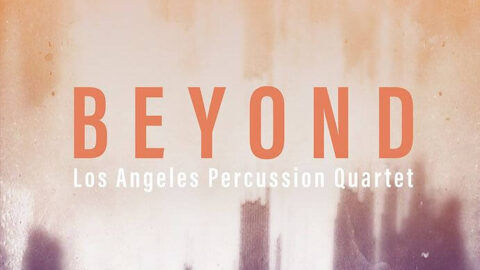An overexposed photograph of a city skyline, weathered and warped by time. The crisp lines which once separated buildings, clouds, and a warm evening sky have faded. At passing glance, the image possesses a strikingly beautiful simplicity. With prolonged examination, it is easy to fall ever more deeply into a nostalgic, yet unexpected journey through the nuanced textures and colors, and this visual experience of the album cover photograph by Collin J. Rae marvelously introduces the aesthetic vision of Beyond, the newest CD release by the Los Angeles Percussion Quartet (LAPQ).
The album from the Sono Luminus label features works by composers who are well known both to the LAPQ and the vibrantly diverse LA music scene. Individually, the works are sincere, compelling, and distinctly representative of each composer’s own unique personality. Collectively, they are joined by a playful yet deeply reflective aesthetic unique to the west coast. The curation of these works creates a cohesive programmatic experience which is at once breathtakingly fresh and warmly familiar. Masterfully recorded in both hi-fi CD and Blu-Ray surround sound quality, Beyond captures the authenticity and vivacity of a live performance while taking full advantage of recorded precision.

Qui Tollis (2013) by Icelandic composer Daníel Bjarnason delivers on its titular religious reference, creating a cavernous soundscape akin to the interior of an empty cathedral. It begins with the faintest quivering of numerous bells emerging from total silence, drawing meditative attention as they slowly coalesce into a delicate shimmering texture. Qui Tollis does not linger, transitioning explosively between pounding drums, sweeping electronic-like effects, and slowly pulsating metallic drones. This palate alludes to Bjarnason’s collaborations with such artists as the Icelandic Sigur Ros and the Danish Efterklang. These sounds are executed by the LAPQ with such conviction that a careless listener might mistake these acoustic sounds for their electronic counterparts.
Aura (2015) by Anna Thorvaldsdottir materializes from the silence following the end of Qui Tollis. Broadly, Thorvaldsdottir’s work draws upon natural influences, often portraying vast soundscapes organically created by the convergence of multiple independent voices. This revelatory and expansive compositional approach is displayed in Aura through her masterful deconstruction and reconstruction of instrumental sounds and timbres. The LAPQ renders this with an impressive depth of ensemble sound, creating an endlessly folding and unfolding texture. It is easy simply to become lost in listening to the subtleties of the brushing of a drum head or the bowing of a vibraphone. Aura resists aimlessness as a haunting bell motive keeps the listener from straying too far.
Bjarnason and Thorvaldsdottir’s works suggest a programmatic approach, yet they pleasantly obscure specific reference and allusion. Memory Palace by Christopher Cerrone gives way to fully formed nostalgia in the form of a five movement work representing five locations from his life. Cerrone describes a memory palace as “an ancient technique of memorization that helped orators remember very long speeches by placing mental signposts in an imaginary location and ‘walking’ through it.” Each location is physically and sonically preserved through the use of homemade instruments, such as a restrung guitar or tuned glass bottles. These objects are played against a tapestry of recorded sounds from these locations to create a sonic memory palace. The LAPQ sensitively portrays Cerrone’s sincerely constructed narrative, communicating simultaneously a distinct sense of location and distance through seamless blending of repurposed and traditional instruments with electronic sounds.

Fear Release by Ellen Reid showcases the LAPQ’s attention to sonic detail with an entirely new character. Comprised almost exclusively of bells and metal keyed instruments, the work demonstrates a curiosity which reflects Reid’s dynamic and well-traveled career as composer and sound artist. Fear Release is unexpected and defies anticipation, transitioning effortlessly from reflective soundscapes to darting, energetic rhythmic passagework. These transitions are further enriched by the stunning mastering which give even the fastest passages full depth and dimension.
I Hold the Lion’s Paw (2013-2014) is an expansive 40 minute exploration of unfolding micro and macro processes within Andrew McIntosh’s detailed microtonal and timbral compositional language. These micro processes are explored through a series of instrumental textures, comprised of a variety of traditional and non-traditional instruments including cymbals, snare drums, microtonal bells, and bowls tuned with water. The detail of sound the LAPQ finds in these instruments is subtle and controlled. The quartet draws out barely perceptible timbral variations in cymbal strikes and impressively prolongs a detuning effect through the slow paced addition of water to the bowls. In homogenous sections, these subtleties are laid bare. Yet the greatest interest occurs at a macro level through the juxtaposition and overlaying of these richly diverse textures.
With Beyond, the LAPQ achieves a level of artistic virtuosity which often exists only as a concept. The interpretation of each work on Beyond prepares and pushes you to make previously impossible discoveries in the next. It is this gently guiding programmatic force, the unrelenting sonic precision of the LAPQ masterfully captured and produced which makes Beyond a standout album regardless of genre or classification.
























